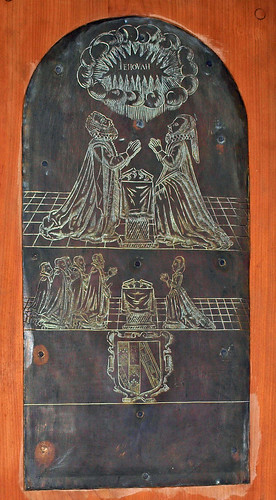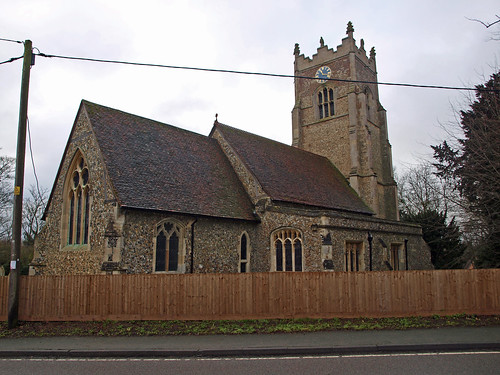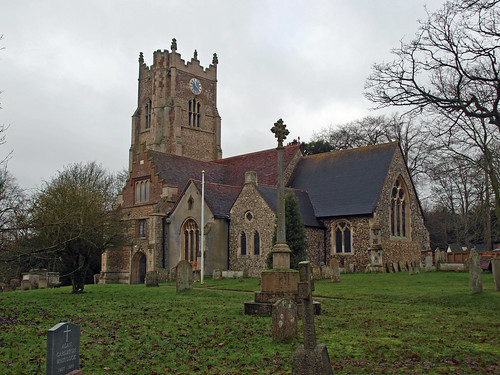From the road it appears to be a fairly run of the mill flint and rubble building consisting of the English style chancel, nave, a north aisle and an obviously later brick and flint tower - pleasant enough but run of the mill.
The porch started life as the first stage of an abandoned tower and gives the church a certain majesty which the, as expected, over-restored interior does not quite live up to, however there's enough of interest to make the sum of its parts, whilst maybe not a knee trembler, certainly worth a visit.
ST ANDREW. Entirely Perp. Nave, N aisle and chancel mid C14, but the N arcade redone in 1884. For reasons not convincingly explained a huge W tower was added to the nave on its S side, near the W end. It was begun later in the C14, with angle buttresses and a big S doorway enriched by an ogee canopy and two niches l. and r. This was not continued and later given a blank stepped brick gable as a piece of decoration. Instead, late in the C15, a more normal W tower was erected, also with angle buttresses. It has bell-openings of three lights with one transome, stepped battlements with pinnacles and, between them, in the middle of each side, a smallish figure of an angel. - PULPIT. Elizabethan, with two tiers of blank arches with plaited decoration on each panel. - SCREEN. One-light divisions with ogee tops and a little tracery above them. On the r. side of the screen the dado is painted with figures of saints, in the East Anglian manner. The quality of the paintings is low. - BRASS. Plate with arched top and kneeling figures, Symonds family, 1627. - (MONUMENT. Mr Gunnis mentions Gregory Way d. 1799, by John Bacon.)

GREAT YELDHAM. At its heart stands the huge Yeldham Oak, 30 feet round and perhaps 1000 years old; and in its beautiful churchyard is a hollow elm. They are the grand old men of this pleasant place, the oak probably twice as old as the oldest of Great Yeldham’s charming houses.
One of them is Spaynes Hall of the 17th and 18th centuries; another is an inn going back to 1500, with a Tudor chimney-stack, a fine door at the back, and woodwork 300 years old; and a third is beautiful Yeldham Hall, built of timber and plaster in the 16th and 17th centuries, and still keeping its old panelling and balusters.
Older than most of these houses is the church, which comes from the 14th and 15th centuries. Its tower has angels on the parapet. Its porch is the lowest storey of an earlier tower which was either never finished or partly pulled down. It has an outer doorway with much beauty from the 14th century, and a Tudor room above. The door itself is 600 years old, and has kept its ancient handle and a long iron strap. A little doorway in the nave wall was meant to lead to the turret of the unfinished tower. On the 15th century screen are remains of a painting showing a bishop and a lady with a crown. The pulpit is Jacobean, and there are two chests and a carved chair from the 17th century. Timbers 500 years old are over the north aisle. In the 15th century south chapel is a brass showing Richard Symonds of 1627, kneeling with his wife and looking up at a cloud with the word Jehovah. Their six children are at another desk below. In the vestry, we found a picture of old George Hardy, who knew every stone of this ancient place, for he was singing in the choir for three-quarters of a century.
An old timbered dovecot, seen from the road, has a pyramid roof.
Simon K -
A better and more impressive church outside than in. It was rather dark inside - I nearly missed the screen paintings of Saints, and only remembered them as I was leaving. I did like the glass though - unusual workshops of the late 19th Century/early 20th Century, which I shall have to find out about. I noticed the bench to John Suddard. he was vicar here in the 1990s, and last year was murdered in his Somerset vicarage by a mentally ill man with an anti-Christian fixation.
Flickr set.


No comments:
Post a Comment